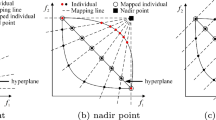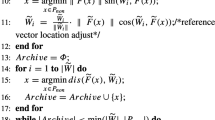Abstract
In order to estimate the Pareto front, most of the existing evolutionary algorithms apply the discovery of non-dominated solutions in search space, and most algorithms need appropriate diversity. Sometimes the Pareto front is so much thin and several dominated solutions exist beside the Pareto front. This paper proposes a new inverse model-based evolutionary algorithm with multiple reference vectors in order to exact place of possible Pareto front and then a collection of the exact places of vectors are produced and through this collection, the solutions which are beside the Pareto front mapping to the hyperplane and clustered in order to produce more effective reference vectors point to Pareto front which ultimately leads to the proper guide of diversity and convergence of population. The suggested method has been experimented on the benchmark test suite for CEC’2018 Competition (MaF1–15) and Walking Fish Group (WFG)) and expresses that the suggested strategy is encouraging.



















Similar content being viewed by others
References
Cheng, R.: Nature inspired optimization of large problems. Ph.D. thesis, University of Surrey (2016)
Cheng, R., He, C., Jin, Y., Yao, X.: Model-based evolutionary algorithms: a short survey. Complex Intell. Syst. 4(4), 283–292 (2018)
Hua, Y., Jin, Y., Hao, K., Cao, Y.: Generating multiple reference vectors for a class of many-objective optimization problems with degenerate pareto fronts. Complex Intell. Syst. 6, 272–285 (2020)
Krejca, M.: Theoretical analyses of evolutionary algorithms with a focus on estimation of distribution algorithms. In: Proceedings of the 10th Ph.D. Retreat of the HPI Research School on Service-oriented Systems Engineering, vol. 111, p. 129 (2018)
Gao, S., de Silva, C.W.: Estimation distribution algorithms on constrained optimization problems. Appl. Math. Comput. 339, 323–345 (2018)
Cheng, R., Jin, Y., Narukawa, K., Sendhoff, B.: A multiobjective evolutionary algorithm using Gaussian process-based inverse modeling. IEEE Trans. Evol. Comput. 19(6), 838–856 (2015)
Jin, Y.: Surrogate-assisted evolutionary computation: recent advances and future challenges. Swarm Evol. Comput. 1(2), 61–70 (2011)
Liu, B., Zhang, Q., Gielen, G.G.: A Gaussian process surrogate model assisted evolutionary algorithm for medium scale expensive optimization problems. IEEE Trans. Evol. Comput. 18(2), 180–192 (2013)
Lin, Q., Liu, S., Wong, K.-C., Gong, M., Coello, C.A.C., Chen, J., Zhang, J.: A clustering-based evolutionary algorithm for many-objective optimization problems. IEEE Trans. Evol. Comput. 23(3), 391–405 (2018)
Pan, L., He, C., Tian, Y., Su, Y., Zhang, X.: A region division based diversity maintaining approach for many-objective optimization. Integr. Comput.-Aid. Eng. 24(3), 279–296 (2017)
Hua, Y., Jin, Y., Hao, K.: A clustering-based adaptive evolutionary algorithm for multiobjective optimization with irregular pareto fronts. IEEE Trans. Cybern. 49(7), 2758–2770 (2018)
Cheng, R., Jin, Y., Olhofer, M., Sendhoff, B.: A reference vector guided evolutionary algorithm for many-objective optimization. IEEE Trans. Evol. Comput. 20(5), 773–791 (2016)
Liu, Q., Jin, Y., Heiderich, M., Rodemann, T., Adaptation of reference vectors for evolutionary many-objective optimization of problems with irregular pareto fronts. In: IEEE Congress on Evolutionary Computation (CEC), pp. 1726–1733. IEEE (2019)
Ge, H., Zhao, M., Sun, L., Wang, Z., Tan, G., Zhang, Q., Chen, C.P.: A many-objective evolutionary algorithm with two interacting processes: cascade clustering and reference point incremental learning. IEEE Trans. Evol. Comput. 23(4), 572–586 (2018)
Zhang, Q., Zhou, A., Jin, Y.: RM-MEDA: a regularity model-based multiobjective estimation of distribution algorithm. IEEE Trans. Evol. Comput. 12(1), 41–63 (2008)
Pan, L., He, C., Tian, Y., Wang, H., Zhang, X., Jin, Y.: A classification-based surrogate-assisted evolutionary algorithm for expensive many-objective optimization. IEEE Trans. Evol. Comput. 23(1), 74–88 (2018)
Yang, Z., Qiu, H., Gao, L., Cai, X., Jiang, C., Chen, L.: Surrogate-assisted classification-collaboration differential evolution for expensive constrained optimization problems. Inf. Sci. 508, 50–63 (2020)
Tian, Y., Wang, H., Zhang, X., Jin, Y.: Effectiveness and efficiency of non-dominated sorting for evolutionary multi-and many-objective optimization. Complex Intell. Syst. 3(4), 247–263 (2017)
Rasmussen, C.E.: Gaussian processes in machine learning. In: Summer School on Machine Learning, pp. 63–71. Springer (2003)
Liu, H.-L., Gu, F., Zhang, Q.: Decomposition of a multiobjective optimization problem into a number of simple multiobjective subproblems. IEEE Trans. Evol. Comput. 18(3), 450–455 (2013)
Das, I., Dennis, J.E.: Normal-boundary intersection: a new method for generating the pareto surface in nonlinear multicriteria optimization problems. SIAM J. Optim. 8(3), 631–657 (1998)
Cheng, R., Li, M., Tian, Y., Xiang, X., Zhang, X., Yang, S., Jin, Y., Yao, X.: Benchmark functions for the CEC’2018 competition on many-objective optimization. Technical report (2018)
Huband, S., Hingston, P., Barone, L., While, L.: A review of multiobjective test problems and a scalable test problem toolkit. IEEE Trans. Evol. Comput. 10(5), 477–506 (2006)
Li, M., Yao, X.: Quality evaluation of solution sets in multiobjective optimisation: a survey. ACM Comput. Surv. (CSUR) 52(2), 26 (2019)
Van Veldhuizen, D.A., Lamont, G.B.: Evolutionary computation and convergence to a pareto front. In: Late Breaking Papers at the Genetic Programming 1998 Conference, pp. 221–228 (1998)
Wang, H., Jin, Y., Yao, X.: Diversity assessment in many-objective optimization. IEEE Trans. Cybern. 47(6), 1510–1522 (2016)
Schott, J.R.: Fault tolerant design using single and multicriteria genetic algorithm optimization. Technical Report, Air Force Institute of Technology, Wright-Patterson AFB, OH (1995)
Goli, A., Zare, H.K., Tavakkoli-Moghaddam, R., Sadegheih, A.: Multiobjective fuzzy mathematical model for a financially constrained closed-loop supply chain with labor employment. Comput. Intell. 36, 4–34 (2020)
Zhou, A., Zhang, Q., Jin, Y., Tsang, E., Okabe, T.: A model-based evolutionary algorithm for bi-objective optimization. In: IEEE Congress on Evolutionary Computation, pp. 2568–2575. IEEE (2005)
Deb, K.: Multi-objective Optimization Using Evolutionary Algorithms. Wiley, Hoboken (2001)
Bosman, P.A., Thierens, D.: The Naive MIDEA: a baseline multi–objective EA. In: International Conference on Evolutionary Multi-Criterion Optimization, pp. 428–442. Springer (2005)
Li, K., Omidvar, M.N., Deb, K., Yao, X.: Variable interaction in multi-objective optimization problems. In: International Conference on Parallel Problem Solving from Nature, pp. 399–409. Springer (2016)
Acknowledgements
Financial support from research office of Department of Computer, South Tehran Branch, Islamic Azad University, is acknowledged.
Author information
Authors and Affiliations
Corresponding author
Additional information
Publisher's Note
Springer Nature remains neutral with regard to jurisdictional claims in published maps and institutional affiliations.
Fully documented templates are available in the elsarticle package on CTAN.
Rights and permissions
About this article
Cite this article
Gholamnezhad, P., Broumandnia, A. & Seydi, V. A model-based many-objective evolutionary algorithm with multiple reference vectors. Prog Artif Intell 11, 251–268 (2022). https://doi.org/10.1007/s13748-022-00283-5
Received:
Accepted:
Published:
Issue Date:
DOI: https://doi.org/10.1007/s13748-022-00283-5




